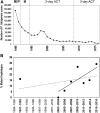Multiple Novel Mutations in Plasmodium falciparum Chloroquine Resistance Transporter Gene during Implementation of Artemisinin Combination Therapy in Thailand
- PMID: 30141388
- PMCID: PMC6159576
- DOI: 10.4269/ajtmh.18-0401
Multiple Novel Mutations in Plasmodium falciparum Chloroquine Resistance Transporter Gene during Implementation of Artemisinin Combination Therapy in Thailand
Abstract
Mutations in the chloroquine resistance transporter gene of Plasmodium falciparum (Pfcrt) are associated with drug susceptibility status of chloroquine and other antimalarials that interfere with heme detoxification process including artemisinin. We aim to investigate whether an increase in duration of artemisinin combination therapy (ACT) in Thailand could affect mutations in Pfcrt. The complete coding sequences of Pfcrt and dihydrofolate reductase (Pfdhfr), and size polymorphisms of the merozoite surface proteins-1 and 2 (Pfmsp-1 and Pfmsp-2) of 189 P. falciparum isolates collected during 1991 and 2016 were analyzed. In total, 12 novel amino acid substitutions and 13 novel PfCRT haplotypes were identified. The most prevalent haplotype belonged to the Dd2 sequence and no wild type was found. A significant positive correlation between the frequency of Pfcrt mutants and the year of sample collection was observed during nationwide ACT implementation (r = 0.780; P = 0.038). The number of haplotypes and nucleotide diversity of isolates collected during 3-day ACT (2009-2016) significantly outnumbered those collected before this treatment regimen. Positive Darwinian selection occurred in the transmembrane domains only among isolates collected during 3-day ACT but not among those collected before this period. No remarkable change was observed in the molecular indices for other loci analyzed when similar comparisons were performed. An increase in the duration of artesunate in combination therapy in Thailand could exert selective pressure on the Pfcrt locus, resulting in emergence of novel variants. The impact of these novel haplotypes on antimalarial susceptibilities requires further study.
Figures

Similar articles
-
Variation in intronic microsatellites and exon 2 of the Plasmodium falciparum chloroquine resistance transporter gene during modification of artemisinin combination therapy in Thailand.Infect Genet Evol. 2018 Nov;65:35-42. doi: 10.1016/j.meegid.2018.07.015. Epub 2018 Jul 20. Infect Genet Evol. 2018. PMID: 30016713
-
Plasmodium falciparum Genetic Diversity in Continental Equatorial Guinea before and after Introduction of Artemisinin-Based Combination Therapy.Antimicrob Agents Chemother. 2016 Dec 27;61(1):e02556-15. doi: 10.1128/AAC.02556-15. Print 2017 Jan. Antimicrob Agents Chemother. 2016. PMID: 27795385 Free PMC article.
-
Sustained Ex Vivo Susceptibility of Plasmodium falciparum to Artemisinin Derivatives but Increasing Tolerance to Artemisinin Combination Therapy Partner Quinolines in The Gambia.Antimicrob Agents Chemother. 2017 Nov 22;61(12):e00759-17. doi: 10.1128/AAC.00759-17. Print 2017 Dec. Antimicrob Agents Chemother. 2017. PMID: 28971859 Free PMC article.
-
Molecular Mechanisms of Drug Resistance in Plasmodium falciparum Malaria.Annu Rev Microbiol. 2020 Sep 8;74:431-454. doi: 10.1146/annurev-micro-020518-115546. Annu Rev Microbiol. 2020. PMID: 32905757 Free PMC article. Review.
-
PfCRT and its role in antimalarial drug resistance.Trends Parasitol. 2012 Nov;28(11):504-14. doi: 10.1016/j.pt.2012.08.002. Epub 2012 Sep 25. Trends Parasitol. 2012. PMID: 23020971 Free PMC article. Review.
Cited by
-
Comparative analysis of targeted next-generation sequencing for Plasmodium falciparum drug resistance markers.Sci Rep. 2022 Apr 1;12(1):5563. doi: 10.1038/s41598-022-09474-5. Sci Rep. 2022. PMID: 35365711 Free PMC article.
-
Polymorphism Analysis of pfmdr1 and pfcrt from Plasmodium falciparum Isolates in Northwestern Nigeria Revealed the Major Markers Associated with Antimalarial Resistance.Diseases. 2021 Jan 4;9(1):6. doi: 10.3390/diseases9010006. Diseases. 2021. PMID: 33406727 Free PMC article.
-
Distribution patterns of molecular markers of antimalarial drug resistance in Plasmodium falciparum isolates on the Thai-Myanmar border during the periods of 1993-1998 and 2002-2008.BMC Genomics. 2024 Mar 11;25(1):269. doi: 10.1186/s12864-023-09814-3. BMC Genomics. 2024. PMID: 38468205 Free PMC article.
-
Transcription and Copy Number Variation of Plasmodium falciparum var2csa among Nonpregnant Malaria Patients in Thailand.Am J Trop Med Hyg. 2024 Nov 19;112(2):266-273. doi: 10.4269/ajtmh.24-0065. Print 2025 Feb 5. Am J Trop Med Hyg. 2024. PMID: 39561405
-
Analysis of sequence diversity in Plasmodium falciparum glutamic acid-rich protein (PfGARP), an asexual blood stage vaccine candidate.Sci Rep. 2023 Mar 9;13(1):3951. doi: 10.1038/s41598-023-30975-4. Sci Rep. 2023. PMID: 36894624 Free PMC article.
References
Publication types
MeSH terms
Substances
LinkOut - more resources
Full Text Sources
Other Literature Sources

